Understanding Rodents: Their Biology and Ecosystem Role
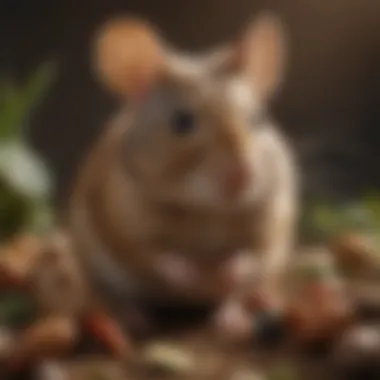
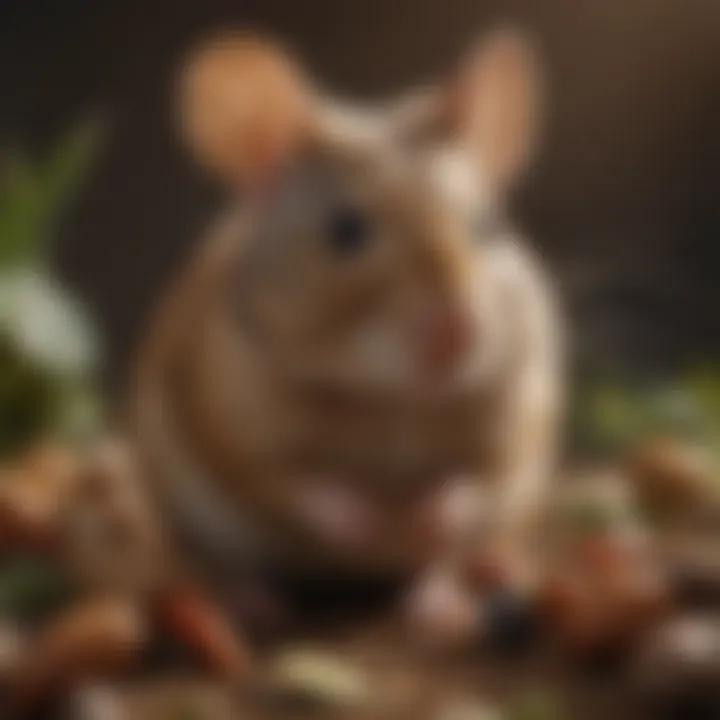
Intro
Rodents are more than just the little critters you see scurrying along the ground or nestled in homes. They possess a fascinating versatility and adaptability that makes them one of the most successful orders of mammals on the planet. With over 2,000 species, their prominence in various ecosystems cannot be understated.
This article sets out to explore the multifaceted world of rodents, touching on their biology, behavior, and the roles they play in our ecosystems. Rodents can slice through the urban landscape just as easily as they can thrive in wild terrains. Most notable is their striking evolutionary journey, which has enabled them to occupy niches that few other species venture into.
Moreover, when we talk about rodents, we often grapple with their dual identity as pets and pests. They have carved their niche in our lives; on one hand, they provide companionship and joy when domesticated, while on the other, they can wreak havoc on crops and stored food when they enter our homes. This article will unpack these contradictions, providing insights into how rodents have managed to weave themselves into the very fabric of human existence.
By the end, the reader should be equipped with a well-rounded understanding of these remarkable creatures, allowing for a better appreciation of their significance in our world.
Prelims to Rodents
Rodents, often overlooked in the grand tapestry of the animal kingdom, hold an awe-inspiring significance that can’t be dismissed. Their sheer adaptability and variations are what make the study of these creatures not just important but vital in understanding broader ecological systems. In this section, we’ll dig deeper into the definition of rodents and explore the reasons why their study is essential in a world that often overlooks the smaller inhabitants.
Defining Rodents
Rodents belong to the order Rodentia, a diverse group known for their distinctive characteristic of having continuously growing incisors. This means they are built to gnaw; it’s practically in their DNA. The biggest family, Muridae, contains species such as mice and rats, but the order includes many others, like squirrels from the Sciuridae family or the friendly guinea pigs from Caviidae.
In terms of size, rodents range from the tiny African pygmy mouse to the much larger capybara, a true giant among its peers. What sets these creatures apart is not just their size, but their ecological roles and relationships with other species. Their presence is felt worldwide, from urban areas where they thrive on human leftovers to remote forested regions where their populations are integral to local ecosystems.
Why Study Rodents?
Studying rodents opens a window into understanding various biological and environmental dynamics. Here are some crucial points underlining the importance of studying these creatures:
- Ecological Indicators: Rodents often serve as indicators of environmental health, acting as proxies for changes in habitat and climate. Their populations can signal shifts that may affect larger ecosystem functionalities.
- Behavioral Insights: Observing rodent behavior can lead to insights into social structures and adaptability. For instance, the differing foraging strategies seen in urban rats versus woodland mice illustrate how behavior evolves in relation to environment.
- Impact on Agriculture: Given their diets, rodents can either be beneficial or detrimental to agricultural practices. Understanding their feeding behaviors can inform pest control strategies that mitigate damage while also promoting biodiversity.
- Scientific Research: Rodents like laboratory mice are pivotal in medical research. Their genetic similarities to humans make them essential for studying diseases and testing treatments.
"Rodents are the silent participants in the dance of life, influencing every step we take toward understanding our ecosystems."
In summary, this introductory exploration of rodents sets the stage for a deeper dive into their biological traits and behavioral patterns that tailor our understanding of their role in the environment. As we delve further, we’ll unravel their complexities, highlighting both their crucial contributions and challenges amidst human interaction.
Classification of Rodents
Understanding the classification of rodents offers insightful perspectives into their diversity and ecological significance. With over 2,000 species spanning across various environments and lifestyles, rodents form a crucial component of many ecosystems. The idea of classifying these creatures is not just a scientific endeavor; it has practical implications for conservation, pest control, and even understanding their role in human society. By breaking down the various families and characteristics of rodents, we can appreciate their complexity and interrelatedness within the animal kingdom.
Taxonomy Overview
Rodents are part of the order Rodentia, which is further classified into families based on evolutionary traits and anatomical features. The taxonomy of rodents can sometimes appear intricate, but it essentially helps in understanding the distinct ways different groups have adapted to their habitats. In a nutshell, rodents are categorized mainly through their morphology, reproductive habits, and ecological niches.
Typically, classification involves several hierarchical levels: order, suborder, family, and genus, among others. For those venturing into the study of rodents, having a grasp of taxonomy serves as a cornerstone. It provides a framework that highlights relationships between species and habitats. The classification also sheds light on their social behavior, diets, and habitats, making it easier for researchers and animal enthusiasts alike to focus on specific types based on personal interest or need.
Major Families of Rodents
The major families of rodents include Sciuridae, Cricetidae, Muridae, and Chinchillidae, each possessing unique features that contribute to their ecological roles and human interactions.
Sciuridae (Squirrels)
The family Sciuridae includes a variety of squirrels, such as tree squirrels and ground squirrels. These creatures are well known for their bushy tails and agile acrobatics. A notable characteristic of Sciuridae is their exceptional dexterity and climbing abilities. These traits allow them to navigate trees efficiently in search of food. Squirrels are an important link in the food chain, serving as prey for numerous predators, and they also play a role in seed dispersal, fostering new plant growth.
However, their presence can fluctuate based on environmental conditions, making them a sensitive indicator of ecosystem health. Understanding squirrels can offer glimpses into broader ecological dynamics, making this family a valuable case study in the classification of rodents.
Cricetidae (Hamsters and Voles)
Cricetidae is a fascinating family that includes hamsters and voles. These species are often appreciated for their playful and engaging nature in captivity, particularly hamsters. A key feature of this family is their burrowing behavior, which allows them to create complex underground networks. This activity not only provides them shelter but also contributes to soil aeration and nutrient cycling in their habitats.
Cricetidae species are also known for their varied diets, ranging from seeds to fruits, which makes them adaptable to different environments. Yet, their populations can swell rapidly under favorable conditions, posing challenges for human habitation. This duality emphasizes the importance of understanding Cricetidae’s ecological roles in both urban and natural settings.
Muridae (Mice and Rats)
Muridae stands as the largest family within the rodent classification, encompassing species such as house mice and brown rats. With their adaptability to numerous environments, these rodents have become synonymous with human habitats. A defining feature of Muridae is their prolific breeding habits, enabling swift population increases, often in urban areas. These rodents are significant not just ecologically, but also in their impact on agriculture and public health.
While some view them as pests, others recognize their role in scientific research and education. Their capacity for learning and problem-solving has even made them vital models in laboratories for studying various human diseases. The cultural association of Muirdae with humans also opens discussions about coexistence and management.
Chinchillidae (Chinchillas)
Chinchillidae, chiefly represented by chinchillas, are renowned for their soft fur and unique patterns. Unlike many rodents that are well-adapted to various environments, chinchillas originate from the high altitudes of the Andes mountains. Their key characteristic lies in their specialized adaptation to cold, dry climates, which showcases how environmental pressures can shape rodent adaptations.
However, chinchillas also face threats from habitat loss and illegal pet trade. Their situation highlights the significance of conservation efforts and the need for understanding specific rodent families within ecological frameworks. Despite their challenges, chinchillas' captivating appearance has made them popular as exotic pets, illustrating the intersection of wildlife and human interest.
Through exploring these families, we uncover the rich tapestry that forms the world of rodents. It's not merely an academic exercise; understanding classification engenders appreciation, which in turn fosters conservation and humane coexistence.
Anatomy and Physical Characteristics
Understanding the anatomy and physical characteristics of rodents is crucial to grasp their adaptability and survival strategies. Rodents are characterized by specific features that not only define their appearance but also affect their behavior, diet, and habitat choices. This section unpacks these distinctive elements, emphasizing their importance in the overall context of rodent life.
Distinctive Features of Rodents
Rodents, belonging to the order Rodentia, are unique in several respects. A prominent feature is their continuously growing incisors. These sharp teeth are adaptive tools for gnawing, which allows them to feed on a variety of materials, from seeds to wood. This trait is vital as it directly influences their feeding behavior and habitat interaction. Moreover, their size can vary widely among species, but many share a similar basic body structure that includes a compact frame, long tails, and often, a rotational capacity of their ears. Such features have evolved over time, providing rodents with mechanisms to thrive in diverse environments.
Sensory Abilities
Vision
Vision in rodents is fascinating due to its unique adaptations. Most rodents have large eyes that provide a wide field of view. This, combined with their ability to see well in low light, is beneficial for spotting predators while foraging. However, their color perception is somewhat limited, primarily seeing blues and greens. The key characteristic here is their excellent motion detection, which is invaluable in the wild.
Advantages of this quality are twofold: it not only aids in navigating through their habitats but also enhances foraging efficiency while avoiding danger, a crucial element to their survival.
Hearing
Hearing is another essential sensory aspect for rodents. Their ears are often large and flexible, contributing to their keen auditory abilities. This trait enables them to detect high-frequency sounds, making it easier to pick up on both predator-induced threats and opportunities within their environment. For example, the ability to hear the faint movements of a predator can be a lifesaver.
The downside? Large ears can be more susceptible to damage, especially in wild environments. Still, the advantages outweigh the risks as this ability forms a vital part of their alert system.
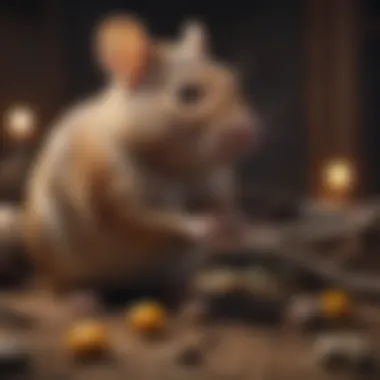
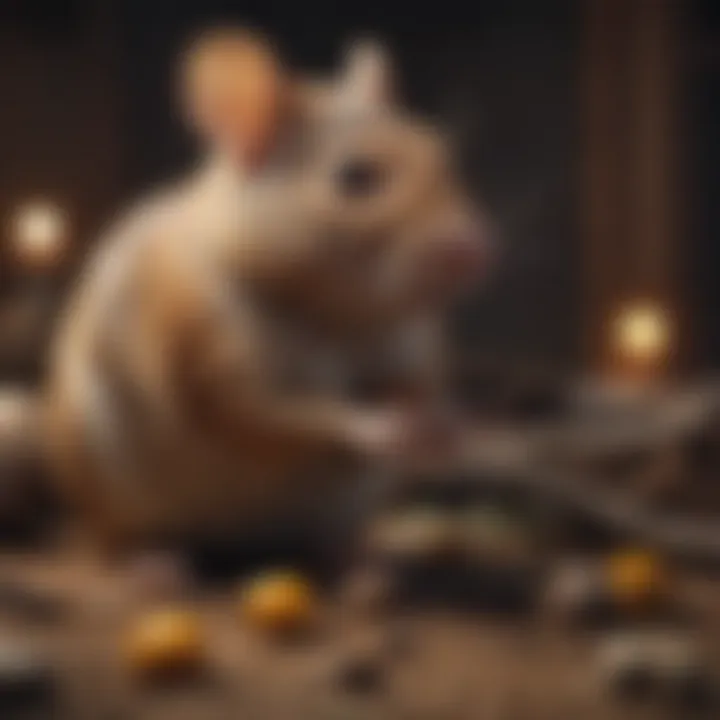
Sense of Smell
When it comes to the sense of smell, rodents excel remarkably. This acute olfactory ability allows them to locate food, identify mates, and detect predators. Rodents like rats are known to have a highly developed sense of smell; they can even recognize scents that are days or weeks old. This characteristic plays an integral role in their survival strategies and social interactions, guiding them in making crucial behavioral decisions.
"In the world of rodents, the ability to navigate using scent is akin to having a map that updates in real-time, making them adept at survival in ever-changing environments."
The benefits of a strong sense of smell are clear: not only does it enhance foraging success, but it also fosters social bonding through scent marking, which can also signify territory.
In summary, the anatomy and sensory abilities of rodents are not just interesting aspects of their biology; they form the backbone of how these creatures interact with their world, shaping their behaviors and survival in profound ways. The combination of their physical traits and sensory capabilities illustrates why rodents play such a pivotal role in ecosystems and why they continue to captivate researchers and enthusiasts alike.
Habitat and Distribution
Understanding the habitat and distribution of rodents is vital for grasping their ecological roles and adaptations. Rodents are remarkably versatile creatures, able to thrive in various environments, which makes them one of the most widespread groups among mammals. Their habitats not only affect their survival but also influence their interactions with other species, including humans. By exploring these aspects, we aim to illuminate the significance of rodents in our ecosystems and how various factors like climate and human activity shape their habitats.
Global Distribution of Rodents
Rodents are found on every continent except Antarctica, showcasing their incredible adaptability. Areas with dense vegetation offer numerous resources, while urban areas present unique challenges and opportunities. For instance, rodents like the common house mouse have successfully adapted to human environments, cohabitating with us in cities worldwide.
Key Points of Global Distribution:
- Adaptability: Rodents can adjust to diverse climates and landscapes.
- Widespread: From the moors of Scotland to the streets of New York, rodents make their homes nearly everywhere.
- Human Influence: Urban expansion impacts the movement and habitats of rodent populations, often forcing them into closer quarters with people.
Preferred Habitats
Rodents exhibit distinct preferences for their habitats, and these choices significantly impact their behavior and ecology. The diversity in their habitats is often reflective of their feeding habits, nesting behaviors, and predator avoidance strategies.
Urban Environments
Urban environments are a fascinating study in rodent adaptation. Cities offer a treasure trove of food scraps and shelter, leading to a thriving rodent population. These spaces allow rodents to nest in unexpected nooks and crannies, often becoming unwelcome guests in homes and businesses.
- Key Characteristics: Abundance of food and nesting sites.
- Benefits: Rodents can adapt their feeding behaviors to exploit human waste and leftovers. This flexibility showcases their prowess in surviving alongside humans.
- Unique Features: The constant hustle of city life provides safety from natural predators, at least in the short term.
- Challenges: However, urban settings also bring threats such as extermination efforts and habitat fragmentation.
Forests and Grasslands
Forests and grasslands provide more natural and expansive habitats for rodents like voles and ground squirrels. These environments support a diverse range of plants, which in turn sustains various herbivorous rodents.
- Key Characteristics: Dense vegetation and open spaces offer both cover and food.
- Benefits: Rich ecosystems found in these areas help rodents maintain a healthy diet consisting of seeds and greens.
- Unique Features: The presence of underground burrowing systems in grasslands allows for safer nesting and access to food.
- Dangers: However, their open habitats also expose them to natural predators, making survival more competitive.
Deserts
Rodents in desert areas, such as kangaroo rats, have adapted in remarkable ways to survive harsh conditions with minimal water. Deserts may seem inhospitable, but these creatures have found unique niches.
- Key Characteristics: Limited vegetation and scarce resources differentiate deserts from other habitats.
- Benefits: Adaptations like nocturnal behavior help rodents avoid the scorching sun and lower water loss. Some species can metabolize moisture from their food.
- Unique Features: Their efficient burrowing and foraging strategies minimize exposure to predators and extreme temperatures.
- Challenges: The scarcity of resources often leads to low population densities, impacting genetic diversity and resilience.
Understanding where rodents thrive and how they interact with their environments is crucial for recognizing their ecological importance. With ever-changing landscapes due to human activity, it’s essential to keep tabs on these furry residents and learn how they contribute to the overall health and balance of our ecosystems.
Rodents may be small, but their impact on the environment is anything but. Their adaptability and resilience are key to maintaining ecological balance.
Diet and Feeding Behavior
Understanding the diet and feeding behavior of rodents is essential to grasping their role in ecosystems. Rodents have evolved a plethora of dietary strategies that influence their survival, reproduction, and ecological interactions. These feeding habits not only affect their populations but also impact their environments and co-existing species. Furthermore, for those considerin' them as pets, knowing their dietary needs is critical for their health and happiness.
Types of Diets
Herbivorous
Herbivorous rodents primarily consume plant matter. This characteristic is significant as it allows them to act as key players in ecosystem structure. For instance, species like the Eastern Chipmunk are often seen munching on seeds and nuts, helping to disperse and grow new plants. Being herbivorous is a beneficial feature for such creatures, as they can usually find food easily in diverse habitats.
A unique feature of herbivorous rodents is their constant gnawing. Their incisors grow continuously, so they must chew vigorously on fibrous materials to prevent overgrowth. While this habit can be a hassle for pet owners, particularly with furniture, it is vital for their well-being in the wild
Advantages:
- Abundance of plant materials for sustenance
- Role in seed dispersal and plant community health
Disadvantages:
- Need to constantly chew leads to dental issues if not managed
Omnivorous
Omnivorous rodents consume a mixed diet of both plant and animal matter. This adaptability allows them to thrive in various environments, from rural areas to urban centers. Take the common house mouse, for example; it's just as likely to nibble on grains as it is to indulge in leftover scraps from human meals. The omnivorous nature of these rodents makes them resilient and widely spread.
A unique aspect of omnivorous rodents is their ability to take on different feeding strategies depending on food availability, which can be a lifeline during lean times. This flexibility is key in high-demand situations, such as competing for food against many other species or during seasonal changes.
Advantages:
- Flexibility in diet allows survival in varying conditions
- Can capitalize on the abundance of food sources
Disadvantages:
- Increased risk of disease transmission by consuming carrion or contaminated food
Feeding Strategies
Rodents employ various feeding strategies that enhance their survival and reproductive success. For example, some species have developed foraging techniques that help them efficiently locate food. Here are a few notable strategies:
- Caching: Many rodents, like squirrels, are known for storing food in burrows or hollows, which provides a critical resource during harsh weather or when food is scarce.
- Grooming and Sorting: Certain rodents, such as rats, will sort through food items meticulously. They might discard undesirable bits before consuming only the most nutritious portions.
- Social Foraging: Some rodent species engage in social behavior while feeding, which can lead to greater efficiency in finding food when living in groups.
Ultimately, the diverse diets and feeding behaviors of rodents illustrate their important role within ecosystems, displaying their adaptability and significance in a balanced environment.
Reproduction and Life Cycle
Understanding the reproduction and life cycle of rodents provides significant insights into their biological success and adaptability. This knowledge is essential not just for biological study but also for anyone interested in keeping these animals as pets or even managing them as pests. The topic gives glimpses into their population dynamics, how they interact with their environments, and the challenges they face. With such a broad range of species, their reproductive strategies can vary greatly, which reflects their evolutionary pressures.
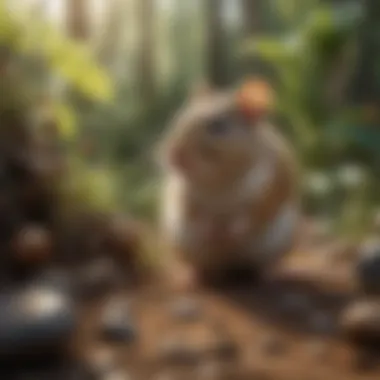
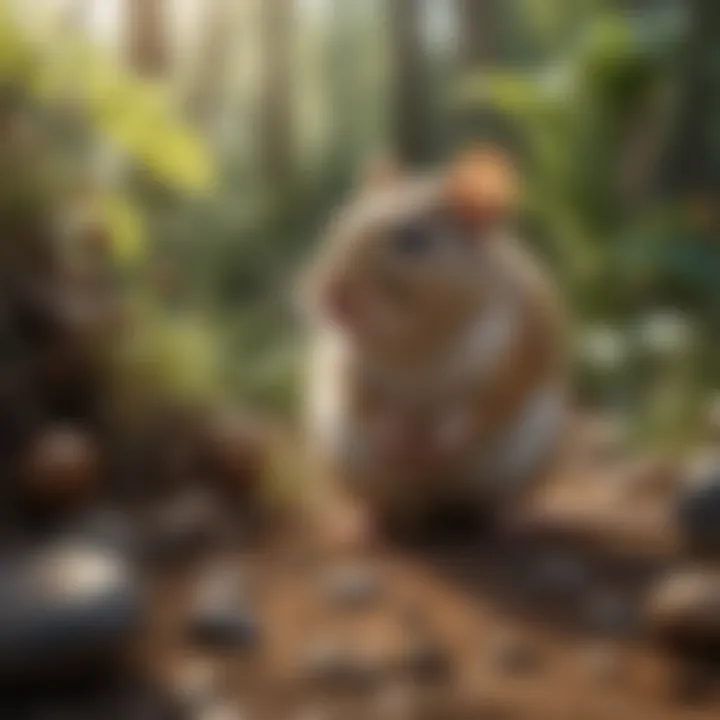
Mating Habits
Mating habits in rodents can be as varied as the species themselves. Most rodents are known for their high reproductive rates, which is a crucial factor in their survival, particularly in the wild. For example, a female house mouse can produce up to 10 litters a year, with each litter containing several young. This prolific breeding is often a response to environmental factors like food availability and habitat conditions.
In many cases, mating is influenced by seasonal changes. For species like the Siberian hamster, breeding tends to occur during the spring when the conditions are more favorable. Rodents often exhibit courting behavior, which can involve vocalizations, scent marking, and even playful interactions.
Some rodents are monogamous, while others are polygamous, reflecting their need to maximize reproductive success. A notable instance is the prairie vole, which forms long-term pair bonds. This social structure fosters a cooperative approach to raising young, ensuring higher survival rates. Conversely, species like rats may have multiple mating partners, relying on sheer numbers to offset the risks of predation and environmental factors.
Gestation and Offspring
After mating, the gestation period can vary widely based on the species. For instance, the typical gestation period for a common rat is around 21 to 23 days, whereas for a capybara, it can be as long as 150 days. This short gestation period allows rodents to reproduce quickly and adapt to the pressures of their environments.
When the young are born, they are often in a vulnerable state. Naked, blind, and helpless at birth, they depend on their mother for warmth and nourishment. Rodent mothers often have a well-defined nursing period during which they care for their offspring intensively. The development stage is crucial, as juveniles learn essential survival skills such as foraging and avoiding predators by observing their mothers. After a few weeks, most young rodents become weaned and start to explore their surroundings, quickly learning to fend for themselves.
Rodent populations can expand quickly given these short gestation periods and large litter sizes. However, the same traits that enhance reproductive success also pose risks—competition for resources, instability in habitats, and an increased likelihood of predation. As a result, only a fraction of these young will survive to adulthood, highlighting the balance between prolific breeding and ecological sustainability.
"The biology of rodents exemplifies nature's strategies for survival—quick reproduction but often at harsh costs."
This reproductive strategy highlights rodent resilience as they navigate their environments, making them an integral part of ecosystems worldwide.
Behavioral Patterns
When exploring the diverse world of rodents, understanding their behavioral patterns is crucial. These patterns not only outline how these creatures interact with each other but also reveal their strategies for survival, reproduction, and adaptation. By observing their behaviors, researchers and pet owners alike can gain insights into the animals' needs, social dynamics, and ultimately, how best to care for them.
Social Structures
Social structures in rodent communities can vary widely depending on species and environmental conditions. Many rodents, like rats and mice, tend to live in social groups called colonies. These colonies can provide numerous advantages, particularly regarding safety in numbers. For instance, when one member of a group is on watch, it allows others to forage or rest. Such collaboration can be vital in avoiding predators, as well as in sharing resources.
On the flip side, some rodents, such as the solitary voles, prefer to live alone. They carve out individual territories that they defend against intruders. Such behavior can reduce competition for food but comes with its own set of challenges since finding mates becomes more difficult.
Understanding the social dynamics of rodents can aid in creating optimal living conditions for pet rodents, ensuring they are comfortable and secure in their environments.
Communication Methods
Effective communication is vital to the survival and well-being of rodents. They utilize various methods to convey messages, facilitate social structures, and warn one another of potential danger. Key to understanding these methods are two components: vocalizations and body language.
Vocalizations
Vocalizations serve as an incredibly important form of communication among rodents. Different sounds indicate different emotions or reactions—be it excitement, fear, or even aggression. For example, young rats are known to emit high-pitched squeaks when they are playing, which signals enjoyment and encourages similar behaviors among their peers.
A key characteristic of rodent vocalizations is their versatility. They can vary not just in pitch but also in volume and duration, allowing for a nuanced form of interaction. Because vocalizations are quick and can carry over distances, they are often the first line of communication in crowded environments, making them a beneficial choice for both wild and domestic scenarios. However, it can also lead to confusion if multiple species share the same habitat, thus highlighting a unique feature of vocalizations: their potential to be misunderstood.
Body Language
Body language is another significant aspect of communication in rodents, offering cues that accompany vocal signals or sometimes stand alone. Rodents can express a myriad of emotions through their body posture, tail movements, and even facial expressions. A familiar sight is a guinea pig puffing up when it feels threatened or submissive, which is a clear sign of its emotional state.
The adaptability of body language makes it invaluable for pet owners. A pet rodent's body posture can often signal its comfort level in various scenarios—from probing playfully to showing distress. Unique features of body language can also relay absolute warnings, such as an irritated hamster raising its fur. It underscores the necessity of recognizing these signals to strengthen the bond between potential pet owners and their rodents, despite the possible challenge of misinterpretation of these subtle cues.
In summary, understanding rodents' behavioral patterns—particularly their social structures and communication methods—provides essential insights for both enthusiasts and pet owners. It enlightens us on how to honor the innate instincts of these small creatures while assuring they lead fulfilling lives.
Rodents as Pets
Rodents have solidified their place in the realm of companionship, flourishing as pets across many households. These small creatures offer more than just adorable appearances; they encompass a range of characteristics and behaviors that can deeply enhance the pet ownership experience. For many families, opting for a rodent as a pet is a wise choice due to their minimal size and generally low-maintenance needs. Even more, they can be a wonderful way to introduce children to the responsibilities of pet care in an approachable manner.
Popular Pet Rodents
Hamsters
Hamsters are often the first type of rodent that comes to mind when discussing pets. These critters are typically nocturnal and prefer to be active when their human families are winding down for the day. Their independence can make them a good option for those who might be busy during the day, but still want the joy of a pet. One of their remarkable traits is their cheek pouches, which they use to store food.
- Key characteristic: Hamsters require less space compared to many other rodents, making them ideal for smaller homes. Their small cages can easily fit on a shelf or desk.
- Unique feature: Their ability to adapt to handling is advantageous, as they can quickly become comfortable with their owners. However, they can be nippy if startled, so gentle interaction is key.
Guinea Pigs
Guinea pigs are charming little beings that stand out for their social nature. Unlike hamsters, they thrive on companionship, either with other guinea pigs or their human caretakers. It’s said that they can even recognize their owners, responding with excitement when they hear familiar voices.
- Key characteristic: Known for their vocalizations, they communicate through a variety of sounds that can indicate their moods and needs. This means they can be quite interactive pets.
- Unique feature: Guinea pigs require a diet rich in hay and vegetables to maintain healthy digestion, which some people may find appealing as it aligns with dietary needs.
Rats
Rats are often misunderstood yet make splendid pets. They are intelligent creatures capable of learning tricks and recognizing their owners, leading to strong bonds. One common misconception is that they are dirty; in reality, rats are quite clean and often designate specific areas for their bathroom needs.
- Key characteristic: Their social nature allows them to thrive in pairs or groups, which can make for entertaining interactions. They can even engage in play with their companions.
- Unique feature: An added advantage is their low-cost care; feeding and housing are affordable compared to larger pets, giving owners more manageable responsibilities.
Care and Maintenance
Taking on a rodent as a pet involves understanding specific care and enrichment needs.
- Housing: Each rodent type requires a different setup. Hamsters, for instance, can live comfortably in smaller cages, while guinea pigs need ample space to move freely.
- Diet: Providing a balanced diet is essential. Commercial pellets are often recommended alongside fresh vegetables, but individual needs can vary.
- Health Considerations: Regular check-ups with a veterinarian specializing in small animals can avert major problems down the line.
- Socialization: Time needs to be dedicated to handling and playing with pets to establish trust and foster adaptability in their environment.
In summary, pets like hamsters, guinea pigs, and rats each bring unique joys and responsibilities. Understanding their specific habits and needs will effortlessly enrich both the pets' and owners' lives.
Rodents as Pests
Rodents, often seen scurrying through fields or darting across alleys, are more than mere nuisances. In urban areas and agricultural settings, their presence can lead to significant problems, affecting not just the environment but also human health and economy. This section examines the implications of rodent infestation in human habitats and explores methods of control that are both effective and humane.
Impact on Human Habitats
The impact of rodents on human habitats ranges from minor annoyances to severe consequences. In homes, rodents like mice and rats may seek shelter. When they do, they can cause damage by chewing on wires, insulation, and even structural components. This can lead to costly repairs and potential fire hazards. Additionally, rodents are notorious for their role in spreading diseases. Common diseases linked to rodents include leptospirosis, hantavirus, and salmonella. Their droppings, urine, and saliva can contaminate food and surfaces, posing serious health risks to unsuspecting individuals.
"A single pair of rats can produce up to 2,000 descendants in just one year, leading to potential infestations that are hard to control."
In agricultural settings, the destruction is often on a larger scale. Rodents can decimate crops within a short period, leading to significant economic losses for farmers. They might gnaw on stored grains, causing contamination and waste of food resources critical for both humans and livestock. Their ability to reproduce rapidly means that, without intervention, the population can spiral out of control, making management a priority for farmers and urban planners alike.
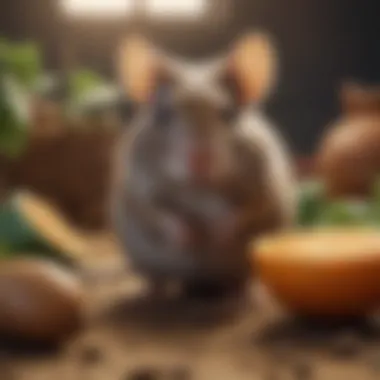
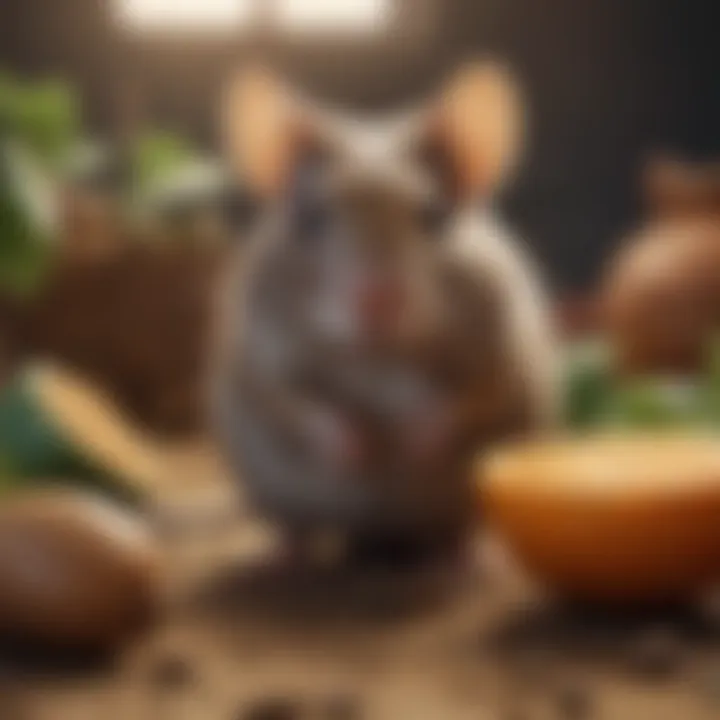
Methods of Control
Controlling rodent populations effectively requires a multi-faceted approach. While traditional methods like traps and poisons are common, they also come with risks, both to non-target animals and to the environment. Here are some methods that have gained favor:
- Prevention Through Cleanliness: Keeping living spaces clean and food properly stored is fundamental in discouraging rodent visits. Sealing up cracks and holes in buildings can also help block entry points.
- Trap Systems: From snap traps to humane catch-and-release traps, using traps ensures a targeted approach. Snap traps are often quick and effective, while humane traps allow for relocation of captured rodents.
- Natural Predators: Encouraging natural predators can be an ecological control method. Cats, for instance, are renowned for their ability to keep rodent populations in check.
- Ultrasonic Repellents: These devices emit high-frequency sounds that are unpleasant for rodents but inaudible to humans. While effectiveness can vary, they’re worth considering for a non-invasive approach.
Rodents in Science and Research
Rodents play a crucial role in scientific exploration, offering unparalleled insights into the biological, psychological, and environmental mechanisms that govern life. Their unique characteristics and adaptability make them ideal subjects for a multitude of research areas. In this context, the significance of rodents extends beyond simple curiosity; they offer answers to some of the most pressing questions in science and medicine, bringing light to pathways that influence both health and ecological balance.
Laboratory Models
When it comes to laboratory research, rodents such as mice and rats are often the stars of the show. Their small size, rapid reproduction, and genetic similarity to humans make them indispensable in various studies. Researchers have utilized these creatures to understand complex biological systems, dissect the workings of diseases, and explore potential treatments for a slew of medical conditions.
- Genetic Studies: Rodents are often genetically modified to study human diseases, including cancer and diabetes. For instance, the C57BL/6 mouse strain is commonly used in metabolic research due to its susceptibility to obesity and diabetes when placed on a high-fat diet.
- Behavioral Research: Their social structures and behaviors also provide a window into psychological disorders and cognitive functions. Observing how rodents interact can shed some light on the effects of stress, anxiety, and social isolation, which are highly relevant to human mental health.
"Rodents offer a living glimpse into the complexities of our biology, helping to forge connections between genetics and health."
In laboratories worldwide, protocols often involve comprehensive testing of rodent models to ensure findings can be translated into effective treatments or interventions for human ailments.
Contributions to Medicine
The contribution of rodents to medicine is genuinely significant. Many advanced medical therapies and interventions derive from research involving these small mammals, which continually bridge the gap between experimental studies and clinical applications. Here are a few critical areas where rodents have made valuable contributions:
- Pharmaceutical Developments: Before a new drug hits the market, it often goes through rigorous testing in rodents to evaluate effectiveness and identify side effects. The data obtained from these studies is fundamental for regulatory approvals.
- Vaccination Research: Historical successes in vaccine development, such as those for polio and more recently for various strains of influenza, have involved rodents. Research models help assess how vaccines react within a living organism, making them essential for public health initiatives.
- Understanding Disease Mechanisms: Rodents have been crucial in unraveling the mechanisms of diseases ranging from Alzheimer's to Parkinson's. By studying these diseases in rodent models, scientists can glean insight into diagnostic and therapeutic strategies that hold promise for combating these conditions.
In essence, without the contributions of rodent-based research, many medical breakthroughs might not have come to fruition or taken years longer to realize. Their role in science not only paves the way for innovative treatments but also allows for adaptable and ethical practices in medical research.
Ecological Roles of Rodents
Rodents are more than just the cute little critters we often keep as pets. They play a vital role in ecosystems, serving as both prey and contributor to environmental health. Their activities have far-reaching implications, affecting everything from plant communities to the animal kingdom. Understanding these ecological roles not only shines a light on their importance but also emphasizes the need for conservation efforts. This section will expose the intricate connections rodents have with their surroundings, particularly in seed dispersal and food chains.
Seed Dispersal
One of the lesser-known but compelling roles rodents play in nature is assisting in seed dispersal. Many rodent species, such as squirrels and chipmunks, have a habit of hoarding seeds and nuts, burrowing them underground for later consumption. While they might go back for a snack, not all seeds are retrieved. This behavior leads to the scattering of seeds, allowing them to germinate into new plants. In a sense, these rodents act as nature’s gardeners, enabling ecosystems to thrive.
- Benefits of Seed Dispersal by Rodents:
- Promotes plant diversity: When rodents scatter seeds, they aid in establishing various plant species, thus enhancing biodiversity in a region.
- Facilitates forest regeneration: By dispersing tree seeds, rodents help in increasing forest density, which is crucial for maintaining habitats.
- Helps manage invasive species: Rodents can help control the spread of invasive plants by dispersing seeds of native species in their place.
Quote: "Rodents are not just pests or pets; they're pivotal players in maintaining the balance of our ecosystems through their seed dispersal activities."
By understanding how these small mammals contribute to seed dispersal, we can appreciate their role in shaping and sustaining forests, grasslands, and urban settings alike.
Role in Food Chains
Rodents occupy a significant spot in various food chains. They are both predators and prey, which means their existence contributes to a balanced ecosystem. Numerous species depend on rodents for sustenance. The interconnectedness of life is vividly displayed through the roles rodents play.
- Predator Relationships:
- Prey Dynamics:
- Owls, hawks, snakes, and even foxes see rodents as a primary food source, highlighting their importance in the food web.
- Through predation pressure, rodents help maintain the population levels of their predators, creating a balance.
- On the flipside, rodents consume a variety of plants and other organisms, impacting plant populations and nutrient cycling.
- The foraging habits of rodents can affect seedling establishment and plant community dynamics.
Challenges Faced by Rodents
The discussion on challenges faced by rodents is not just a side note; it is pivotal to understanding these creatures in the broader ecological context. As both wildlife and subjects of human interest—be it as pests, pets, or research subjects—rodents encounter numerous challenges that can threaten their survival. Knowledge of these challenges equips not only scientists and conservationists but also pet owners and enthusiasts with a deeper insight into the delicate balance of rodent populations and their environments.
Habitat Loss and Conservation
One of the most pressing issues for rodents today is habitat loss. Urbanization, agriculture, and deforestation have steadily encroached on their natural habitats. As trees are cut down or land is repurposed for farms and buildings, rodents like the eastern chipmunk and the North American deer mouse find themselves pushed to the fringe, where survival becomes increasingly challenging. Habitat fragmentation leads to isolated populations that struggle to find mates, which can cause a decline in genetic diversity.
- Key Stats: Studies count that about 75% of global land has been transformed by human activity. This encroachment doesn’t just affect larger mammals; it hits rodents hard as they often depend on specific environments to thrive.
Additionally, conservation efforts are critical in preserving essential habitats. Initiatives that focus on creating wildlife corridors or preserving patches of natural environments can significantly improve the chances for rodent populations. Simple actions, such as planting native vegetation in gardens and supporting local conservation programs, can make a substantial impact. Education about local rodent species and their ecological roles is essential for building communities that respect and protect these animals.
Human-Wildlife Conflict
Human-wildlife conflict is another significant difficulty that rodents face. In many urban settings, rodents—specifically species like rats and mice—compete for resources in neighborhoods, often leading to their demonization as pests. This can result in harsh measures against rodent populations, such as the indiscriminate use of traps or poisons that do not discriminate between species.
- Understanding the Conflict: It’s worth noting that rodents are often not the root cause of issues like food scarcity or sanitation failures, but rather a symptom. They come in search of shelter and sustenance since their natural habitats are compromised.
In rural areas, farmers view certain rodent species as threats to crops. While this is understandable, it leads to cycles of extermination that can disrupt local ecosystems. Effective management could involve employing non-lethal approaches—such as developing better waste management practices or educating farmers on coexistence methods—that promote harmony between human and rodent populations.
"By appreciating rodents and the ecosystems they inhabit, we can cultivate solutions that work for both parties instead of digging trenches of conflict."
Overall, the challenges faced by rodents are complex and interwoven with human activities. Understanding the nuances of habitat loss and human-wildlife conflict is essential for fostering environments where these small creatures can exist and thrive alongside us. The responsibility ultimately lies within our hands—to make informed choices that balance our needs with the well-being of all species.
End
The significance of the conclusion in this article can’t be overstated. It serves as a vital reminder of the multifaceted role that rodents play in our ecosystem while tying together the intricacies discussed throughout the various sections. By summarizing the rich biological characteristics, behavioral patterns, and ecological importance of these creatures, readers can appreciate the complexity of their existence.
Rodents are not just mere inhabitants of our world; they contribute significantly to environmental and scientific dimensions. Pet owners and animal enthusiasts should take keener interest in these dynamic beings.
Summary of Key Points
In this article, we explored numerous facets of rodent life:
- Rodents are a diverse group of mammals that exhibit adaptable traits and behaviors.
- Social structures among rodents can vary significantly, providing a glimpse into their complex interactions.
- Their ecological role is profound, impacting seed dispersal and contributing to various food chains.
- While many see them as pests, understanding their biological and behavioral dynamics helps shift that perspective.
- The human-rodent relationship can be both beneficial and challenging, necessitating thoughtful coexistence.
These key points illustrate how often misunderstood these animals are, revealing their intrinsic value in enriching our ecosystems.
Future Directions in Rodent Research
Looking forward, the future of rodent research holds exciting potential. As urban environments expand, understanding how rodents adapt to changing habitats will be essential. Some potential areas for exploration include:
- Genetic Studies: As science moves further into genetics, unraveling the DNA of various rodent species could unveil insights into their adaptability and resilience in different environments.
- Behavioral Studies: Investigating how urbanization affects social structures and communications could enhance our knowledge of wildlife behavior amidst human expansion.
- Ecological Impact Assessment: Efforts to quantify the impact rodents have on ecosystems, especially in areas heavily altered by human activity, will be invaluable.
- Conservation Strategies: Developing effective conservation strategies to protect rodent populations facing habitat loss is crucial. These strategies must balance their ecological roles with the challenges they present to agriculture and urban living.
As we propel forward into new realms of study, understanding rodents promises to shed light on broader ecological patterns and enhance our comprehension of biodiversity overall.



